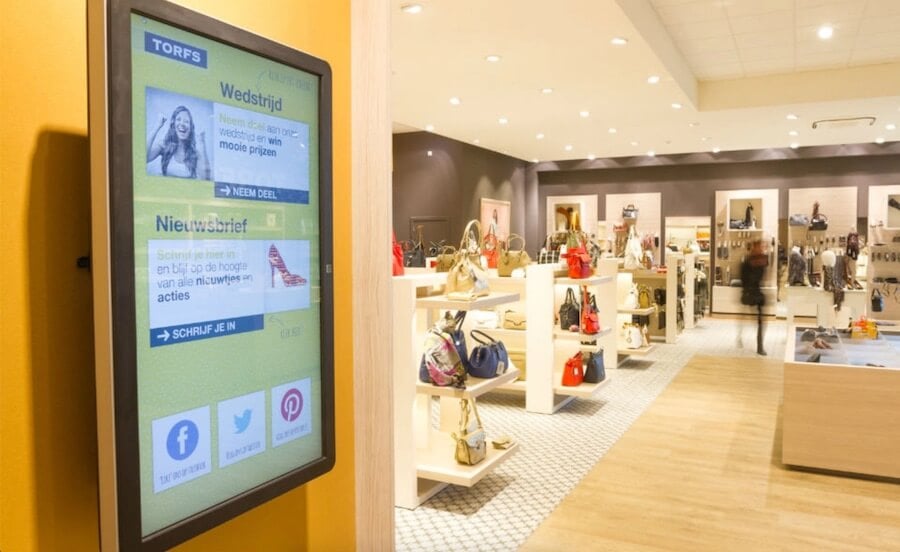Digital marketing is a system of building communications with consumers using digital information channels – smartphones, tablets, TV, digital signage, etc.
The distinctive features of digital marketing are the focus on a personalized approach and information orientation. Knowing the needs and interests of potential customers, digital technologies can effectively convey the necessary information about products or services to consumers and increase customer loyalty.
The advantages of digital marketing are a significant increase in brand awareness, unobtrusive digital advertising, relatively low cost, and the ability to quickly adjust content to specific situations.
Digital signage is an effective digital marketing tool. It can be used in any industry and solve a number of problems:
- Digital signages inform a large number of consumers at the same time.
- Digital signages help people find their way around a big shopping area.
- Digital signages promote a brand.
- Digital signages transmit advertising messages.
- Digital signages provide the ability to load the necessary information remotely as well as update it promptly and manage the content broadcasting.
- Digital signages are used for the online transmission of images from video surveillance cameras, as well as videos from websites, events, etс.
The use of digital marketing technology offers retailers a number of benefits, but remember that the system will not be effective without quality content.
In order for digital signage to grab consumers’ attention, useful and engaging content should be used that is in line with the overall brand promotion strategy.

Digital Signage: The Practice of Application
Currently, digital signage is one of the most promising technologies used for advertising purposes in retail. This type of advertising attracts attention from consumers through the dynamism of the image, a combination of visual and audio components as well as targeting: it is broadcast at the right time, in the right place, and for a particular target audience.
Whereas digital signage previously meant monitors that transmit information, today it is a two-way communication tool for the consumer. Consequently, their scope of application and functions have also expanded:
Interactive interaction of consumers with the brand. For example, shop visitors can use their smartphones to send text messages or photos to the in-store screen and receive discounts or other bonuses in return.
In addition, in-store customer posts and photos from social media can be posted on the screens. Such elements of the game and live communication encourage shop visitors to leave more information about themselves and increase brand loyalty.
Obtaining information for marketing analysis. Using cameras that capture visitors and artificial intelligence software that identifies the gender and age of visitors, digital screens display targeted content that is relevant to the audience currently on the sales floor.
Transfer of some online technologies to the offline space. For example, a digital signage kiosk solution on the sales floor allows customers to get the information they need about a product, view product reviews, check the availability of a size or color in stock, and order home delivery by courier, paying for it on the spot.
In this way, digital signage allows consumers to interact with the brand at multiple levels: at the point of sale, on the organization’s website, in apps, and on social media.
Digital Signage Marketing Strategy – A Necessary Component of Success
Strategy is what helps with business goals of digital signatures, like upselling products. Without a digital signage strategy, it’s difficult to know what to show. Benefits of having a documented digital signage strategy include:
- A solid foundation for great internal communication
- More engagement with your screens
- More user-generated content on social media and feedback sites
- More traffic to your website or other owned channels
- Digital signage content that is easier to update and manage
- The ability to track the results of your digital signage
To create a qualitative digital signage marketing strategy you need:
- Set goals
- Set measurables
- Position your screen(s)
- Define your audience
- Choose content for your audience
- Segment your content times
- Design playlists and schedules
To create an “offline + online” marketing strategy, brands use the omnichannel concept, where all promotion channels are integrated into one whole.
For example, you use digital signage and several online promotion channels. All the data you receive is stacked into a common database. The result is an overall picture of how you communicate with your customers. You can find out how your potential customer behaves online, what their offline behavior is, what to offer them.
Omnichannel provides convenience to the consumer. You can easily change the way you communicate with the customer at any time.
There is no need to collect new data about the user each time he or she changes the channel – all his or her data and history of communication with the brand is already in the common database.
Marketsandmarkets predicts the digital signage market will grow to $27.8 billion by 2026. The reason is that capturing customer attention is becoming increasingly difficult. Companies are looking for new solutions to meet the new habits of modern consumers. And digital signage appears to be that solution.
Conclusion
Summing up, DS systems, used for advertising and information broadcasting, have a great future. Low cost of customer contact, advertising content targeting to a specific customer group as well as their move beyond the Indoor sector to the Outdoor sector make Digital Signage systems a powerful means of mass-dot communications.
Of course, it is unlikely that these systems will replace traditional television, but they will attract a significant part of advertisers, especially in conditions of economic crisis, when television advertising prices are growing, or the current ban of some consumer products’ advertising on television (for example, alcohol and tobacco products).
DS systems are currently developing by leaps and bounds. More and more often we see advertising monitors not only in retail outlets, where they are traditionally widespread but also in buses, minibusses, subways, airports, train stations, gas stations, and car washes. In any case, a digital signature marketing strategy is necessary for any business.




